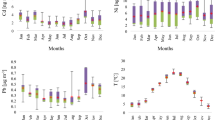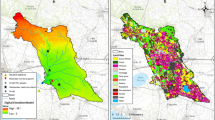Abstract
Background
The aim of this study was to use an integrated exposure assessment approach, combining spatiotemporal modeling of environmental exposure and fate of the chemical to assess the exposure of vulnerable populations. In this study, chlorpyrifos exposure of pregnant women in Picardy was evaluated at a regional scale during 1 year. This approach provided a mapping of exposure indicators of pregnant women to chlorpyrifos over fine spatial and temporal resolutions using a GIS environment.
Methods
Fate and transport models (emission, atmospheric dispersion, multimedia exposure, PBPK) were combined with environmental databases in a GIS environment. Quantities spread over agricultural fields were simulated and integrated into a modeling chain coupling models. The fate and transport of chlorpyrifos was characterized by an atmospheric dispersion statistical metamodel and the dynamiCROP model. Then, the multimedia model Modul’ERS was used to predict chlorpyrifos daily exposure doses which were integrated in a PBPK model to compute biomarker of exposure (TCPy urinary concentrations). For the concentration predictions, two scenarios (lower bound and upper bound) were built.
Results
At fine spatio-temporal resolutions, the cartography of biomarkers in the lower bound scenario clearly highlights agricultural areas. In these maps, some specific areas and hotspots appear as potentially more exposed specifically during application period. Overall, predictions were close to biomonitoring data and ingestion route was the main contributor to chlorpyrifos exposure.
Conclusions
This study demonstrated the feasibility of an integrated approach for the evaluation of chlorpyrifos exposure which allows the comparison between modeled predictions and biomonitoring data.
This is a preview of subscription content, access via your institution
Access options
Subscribe to this journal
Receive 6 print issues and online access
$259.00 per year
only $43.17 per issue
Buy this article
- Purchase on Springer Link
- Instant access to full article PDF
Prices may be subject to local taxes which are calculated during checkout





Similar content being viewed by others
References
WHO. Environmental health inequalities in Europe. Second assessment report. WHO Regional Office for Europe: Copenhagen. 2019.
Wild CP. Complementing the genome with an “exposome”: the outstanding challenge of environmental exposure measurement in molecular epidemiology. Cancer Epidemiol Biomark Prev. 2005;14:1847–50. https://doi.org/10.1158/1055-9965.EPI-05-0456.
Vrijheid M. The exposome: a new paradigm to study the impact of environment on health. Thorax. 2014;69:876–8. https://doi.org/10.1136/thoraxjnl-2013-204949.
Nuckols JR, Ward MH, Jarup L. Using geographic information systems for exposure assessment in environmental epidemiology studies. Environ Health Perspect. 2004;112:1007–15. https://doi.org/10.1289/ehp.6738.
Cui Y, Balshaw DM, Kwok RK, Thompson CL, Collman GW, Birnbaum LS. The exposome: embracing the complexity for discovery in environmental health. Environ Health Perspect. 2016;124:A 137–40. https://doi.org/10.1289/EHP412.
Gavrilescu M. Fate of pesticides in the environment and its bioremediation. Eng Life Sci 2005;5:497–526. https://doi.org/10.1002/elsc.200520098.
Aubertot JN, Barbier JM, Carpentier A, Gril JN, Guichard L, Lucas P, et al. Pesticides, agriculture et environnement: réduire l’Utilisation des pesticides et en limiter les impacts environnementaux. Quæ Editions: Versailles; 2005. French.
Fenske RA, Lu C, Barr D, Needham L. Children’s exposure to chlorpyrifos and parathion in an agricultural community in central Washington State. Environ Health Perspect. 2002;110:549–53. https://doi.org/10.1289/ehp.02110549.
Aschan-Leygonie C, Baudet-Michel S, Harpet C, Augendre M, Lavie E, Grésillon E, et al. Comment évaluer l’exposition aux pesticides de l’air en population générale? Enseignements d’une Revue Bibliographique. Cybergeo. 2015;729; https://doi.org/10.4000/cybergeo.27056.
Fantke P, Jolliet O. Life cycle human health impacts of 875 pesticides. Int J Life Cycle Assess. 2016;21:722–33. https://doi.org/10.1007/s11367-015-0910-y.
Caudeville J. Caractérisation des inégalités environnementales: inventaire des bases de données nationales environnementales et spatialisées. Ineris: Verneuil-en-Halatte. INERIS-DRC-17-164533-00415B; 2017.
Dereumeaux C, Fillol C, Charles MA, Denys S. The French human biomonitoring program: first lessons from the perinatal component and future needs. Int J Hyg Environ Health. 2017;220:64–70. https://doi.org/10.1016/j.ijheh.2016.11.005.
John EM, Shaike JM. Chlorpyrifos: pollution and remediation. Environ Chem Lett. 2015;13:269–91. https://doi.org/10.1007/s10311-015-0513-7.
Eaton DL, Daroff RB, Autrup H, Bridges J, Buffler P, Costa LG, et al. Review of the toxicology of chlorpyrifos with an emphasis on human exposure and neurodevelopment. Crit Rev Toxicol. 2008;38(Suppl 2):1–125. https://doi.org/10.1080/10408440802272158.
Guo J, Zhang J, Wu C, Lv S, Lu D, Qi X, et al. Associations of prenatal and childhood chlorpyrifos exposure with Neurodevelopment of 3-year-old children. Environ Pollut. 2019;251:538–46. https://doi.org/10.1016/j.envpol.2019.05.040.
Rauh VA, Arunajadai S, Horton M, Perera F, Hoepner L, Barr DB, et al. Seven-year neurodevelopmental scores and prenatal exposure to chlorpyrifos, a common agricultural pesticide. Environ Health Perspect 2011;119:1196–201. https://doi.org/10.1289/ehp.1003160.
Dereumeaux C, Saoudi A, Pecheux M, Berat B, de Crouy-Chanel P, Zaros C, et al. Biomarkers of exposure to environmental contaminants in French pregnant women from the Elfe cohort in 2011. Environ Int. 2016;97:56–67. https://doi.org/10.1016/j.envint.2016.10.013.
Fréry N, Saoudi A, Garnier R, Zeghnoun A, Bidondo ML. Exposition de la population française aux substances chimiques de l’environnement. Institut de Veille sanitaire: Saint-Maurice. 2013. French.
Saint-Amand A, Willey J, Werry K, Faure S, Karthikeyan S, Lyonnais-Gagnon P, et al. Fifth Report on Human Biomonitoring of Environmental Chemicals in Canada. Health Canada: Ottawa. 2019.
NHANES. Fourth National Report on Human Exposure to Environmental Chemicals—Volume 1. Atlanta, GA: National Health And Nutrition Examination Survey; 2019.
Schulz C, Angerer J, Ewers U, Heudorf U, Wilhelm M. Revised and new reference values for environmental pollutants in urine or blood of children in Germany derived from the German Environmental Survey on Children 2003-2006 (GerES IV). Int J Hyg Environ Health. 2009;212:637–47. https://doi.org/10.1016/j.ijheh.2009.05.003.
Béranger R, Hardy EM, Binter AC, Charles MA, Zaros C, Appenzeller BMR, et al. Multiple pesticides in mothers’ hair samples and children’s measurements at birth: Results from the French national birth cohort (ELFE). Int J Hyg Environ Health. 2020;223:22–33. https://doi.org/10.1016/j.ijheh.2019.10.010.
Jacquet F, Butault JP, Guichard L. An economic analysis of the possibility of reducing pesticides in French field crops. Ecol Econ. 2011;170:1638–48. https://doi.org/10.1016/j.ecolecon.2011.04.003.
E-Phy. Agence nationale de sécurité sanitaire de l’alimentation, de l’environnement et du travail. 2020. https://ephy.anses.fr/substance/chlorpyrifos. Accessed 4 May 2020.
National Bank of Plant Protection Products Sales by Authorized Distributors. 2020. http://www.data.eaufrance.fr/jdd/bd45f801-45f7-4f8c-b128-a1af3ea2aa3e. Accessed 4 May 2020.
Desert M, Ravier S, Gille G, Quinapallo A, Armengaud A, Pochet G, et al. Spatial and temporal distribution of current-use pesticides in ambient air of Provence-Alpes-Côte-d’Azur Region and Corsica. Fr Atmos Environ 2018;192:241–56. https://doi.org/10.1016/j.atmosenv.2018.08.054.
Synop Essential WMO Database. Météo- France: Saint-Mandé. 2020. https://donneespubliques.meteofrance.fr/?fond=produit&id_produit=90&id_rubrique=32. Accessed 17 Jun 2020.
Leblanc JC, coordination, Sirot V, coordination, et al. Étude de l’alimentation totale française 2 (EAT 2)—Tome 2. Agence nationale de sécurité sanitaire de l’alimentation, de l’environnement et du travail: Maisons-Alfort. 2011. French.
EFSA. The 2013 European Union report on pesticide residues in food. EFSA J. 2015;13:4038 https://doi.org/10.2903/j.efsa.2015.4038.
Davezac H, Grandguillot G, Robin A, Saoult C. L’eau potable en France 2005–2006. French Ministry for Health, Youth and Sports: Paris. 2008. French.
Fantke P, Charles R, de Alencastro LF, Friedrich R, Jolliet O. Plant uptake of pesticides and human health: dynamic modeling of residues in wheat and ingestion intake. Chemosphere. 2011a;85:1639–47. https://doi.org/10.1016/j.chemosphere.2011.08.030.
Fantke P, Juraske R, Antón A, Friedrich R, Jolliet O. Dynamic multicrop model to characterize impacts of pesticides in food. Environ Sci Technol. 2011b;45:8842–9. https://doi.org/10.1021/es201989d.
Bonnard R. Jeux d’équations pour la modélisation des expositions liées à la contamination d’un sol ou aux émissions d’une installation industrielle. Ineris: Verneuil-en-Halatte. DRC-08—94882-16675C; 2010. French.
Dijkman TJ, Birkved M, Hauschild MZ. PestLCI 2.0: a second generation model for estimating emissions of pesticides from arable land in LCA. Int J Life Cycle Assess. 2012;17:973–86. https://doi.org/10.1007/s11367-012-0439-2.
Arnold AC. A comparative study of drop sizing equipment for agricultural fan-spray atomizers. Aerosol Sci Technol. 1990;12:431–45. https://doi.org/10.1080/02786829008959358.
Bertrand M. Consommation et lieux d’achat des produits alimentaires en 1991. INSEE-Résultats. 1993;262-3. French.
Bonnard R. Paramètres d’exposition de l’Homme du logiciel MODUL’ERS. Ineris: Verneuil-en-Halatte. DRC-14-141968-11173C; 2017. French.
Poet TS, Timchalk C, Bartels MJ, Smith JN, McDougal R, Juberg DR, et al. Use of a probabilistic PBPK/PD model to calculate data derived extrapolation factors for chlorpyrifos. Regul Toxicol Pharmacol. 2017;86:59–73. https://doi.org/10.1016/j.yrtph.2017.02.014.
Bois FY, Maszle DR. MC Sim: a Monte Carlo simulation program. J Stat Softw. 1997;2; https://doi.org/10.18637/jss.v002.i09.
Caudeville J, Bonnard R, Boudet C, Denys S, Govaert G, Cicolella A. Development of a spatial stochastic multimedia model to assess population exposure at a regional scale. Sci Total Environ. 2012;432:297–308. https://doi.org/10.1016/j.scitotenv.2012.06.001.
Gotway Crawford CA, Hergert GW. Incorporating spatial trends and anisotropy in geostatistical mapping of soil properties. Soil Sci Soc Am J. 1997;61:298–309. https://doi.org/10.2136/sssaj1997.03615995006100010043x.
Goovaerts P. Geostatistics for natural resources evaluation. 1st ed. Oxford University Press: New York; 1997.
Deziel NC, Frisen MC, Hoppin JA, Hines CJ, Thomas K, Freeman LEB. A review of nonoccupational pathways for pesticide exposure in women living in agricultural areas. Environ Health Perspect. 2015;123:515–24. https://doi.org/10.1289/ehp.1408273.
Alexander BH, Burns CJ, Bartels MJ, Acquavella JF, Mandel JS, Gustin C, et al. Chlorpyrifos exposure in farm families: results from the Farm Family Exposure Study. J Expo Sci Environ Epidemiol. 2006;16:447–53. https://doi.org/10.1038/sj.jes.7500475.
Curwin BD, Hein MJ, Sanderson WT, Striley C, Heederik D, Kromhout H, et al. Urinary pesticide concentrations among children, mothers and fathers living in farm and non-farm households in Iowa. Ann Occup Hyg. 2007;51:53–65. https://doi.org/10.1093/annhyg/mel062.
Arcury TA, Laurienti PJ, Talton JW, Chen H, Howard TD, Barr DB, et al. Pesticide urinary metabolites among latina farmworkers and non-farmworkers in North Carolina. J Occup Environ Med. 2018;60:e63–e71. https://doi.org/10.1097/JOM.0000000000001189.
Whyatt RM, Garfinkel R, Hoepner LA, Andrews H, Holmes D, Williams MK, et al. A biomarker validation study of prenatal chlorpyrifos exposure within an inner-city cohort during pregnancy. Environ Health Perspect. 2009;117:559–67. https://doi.org/10.1289/ehp.0800041.
Egeghy PP, Cohen Hubal EA, Tulve NS, Melnyk LJ, Morgan MK, Fortmann RC, et al. Review of pesticide urinary biomarker measurements from selected US EPA children’s observational exposure studies. Int J Environ Res Public Health. 2011;8:1727–54. https://doi.org/10.3390/ijerph8051727.
Egeghy PP, Quackenboss JJ, Catlin S, Ryan PB. Determinants of temporal variability in NHEXAS-Maryland environmental concentrations, exposures, and biomarkers. J Expo Anal Environ Epidemiol 2005;15:388–97. https://doi.org/10.1038/sj.jea.7500415.
Morgan MK, Sheldon LS, Croghan CW, Chuang JC, Lyu C, Wilson NK, et al. A pilot study of children’s total exposure to persistent pesticides and other persistent organic pollutants (CTEPP). U.S. Environmental Protection Agency: Washington, DC. 2004. EPA/600/R-041/193.
Beal SL. Ways to fit a PK model with some data below the quantification limit. J Pharmacokinet Pharmacodyn. 2001;28:481–504. https://doi.org/10.1023/A:1012299115260.
Hecht M, Veigure R, Couchman L, Barker CIS, Standing JF, Takkis K, et al. Utilization of data below the analytical limit of quantitation in pharmacokinetic analysis and modeling: promoting interdisciplinary debate. Bioanalysis. 2018;10:1229–48. https://doi.org/10.4155/bio-2018-0078.
Byrne SL, Shurdut BA, Saunders DG. Potential chlorpyrifos exposure to residents following standard crack and crevice treatment. Environ Health Perspect. 1998;106:725–31. https://doi.org/10.1289/ehp.98106725.
Zartarian V, Özkaynak H, Burke JM, Zufall MJ, Rigas ML, Furtaw EJ Jr. A modeling framework for estimating children’s residential exposure and dose to chlorpyrifos via dermal residue contact and nondietary ingestion. Environ Health Perspect. 2000;108:505–13. https://doi.org/10.1289/ehp.00108505.
Nolan RJ, Rick DL, Freshour NL, Saunders JH. Chlorpyrifos: pharmacokinetics in human volunteers. Toxicol Appl Pharmacol. 1984;73:8–15. https://doi.org/10.1016/0041-008X(84)90046-2.
Meuling WJA, Ravensberg LC, Roza L, van Hemmen JJ. Dermal absorption of chlorpyrifos in human volunteers. Int Arch Occup Environ Health. 2005;78:44–50. https://doi.org/10.1007/s00420-004-0558-6.
Acknowledgements
The authors would like to thank Dr. Peter Fantke from the Technical University of Denmark (DTU) for courteously providing them the dynamiCROP model. They would like to thank Dr. Torka S. Poet from Battelle Pacific Northwest Division for providing them the PBPK model of chlorpyrifos. They also would like to thank Christian Dersigny from Oise Agricultural Chamber for providing spreading times for chlorpyrifos.
Funding
This research was funded by the French minister in charge of the environment and by the French Biodiversity Agency (Agence française de la biodiversité—AFB) into the Ecophyto 2 plan context.
Author information
Authors and Affiliations
Corresponding author
Ethics declarations
Conflict of interest
The authors declare that they have no conflict of interest.
Additional information
Publisher’s note Springer Nature remains neutral with regard to jurisdictional claims in published maps and institutional affiliations.
Supplementary information
Rights and permissions
About this article
Cite this article
Regrain, C., Zeman, F.A., Guedda, M. et al. Spatio-temporal assessment of pregnant women exposure to chlorpyrifos at a regional scale. J Expo Sci Environ Epidemiol 32, 156–168 (2022). https://doi.org/10.1038/s41370-021-00315-7
Received:
Accepted:
Published:
Issue Date:
DOI: https://doi.org/10.1038/s41370-021-00315-7
This article is cited by
-
Modeling Environmental Fate, Transport, and Transformation of Pesticides: First-Order Kinetic Models for Regional and Global Applications
Reviews of Environmental Contamination and Toxicology (2023)
-
Characterizing environmental geographic inequalities using an integrated exposure assessment
Environmental Health (2021)



